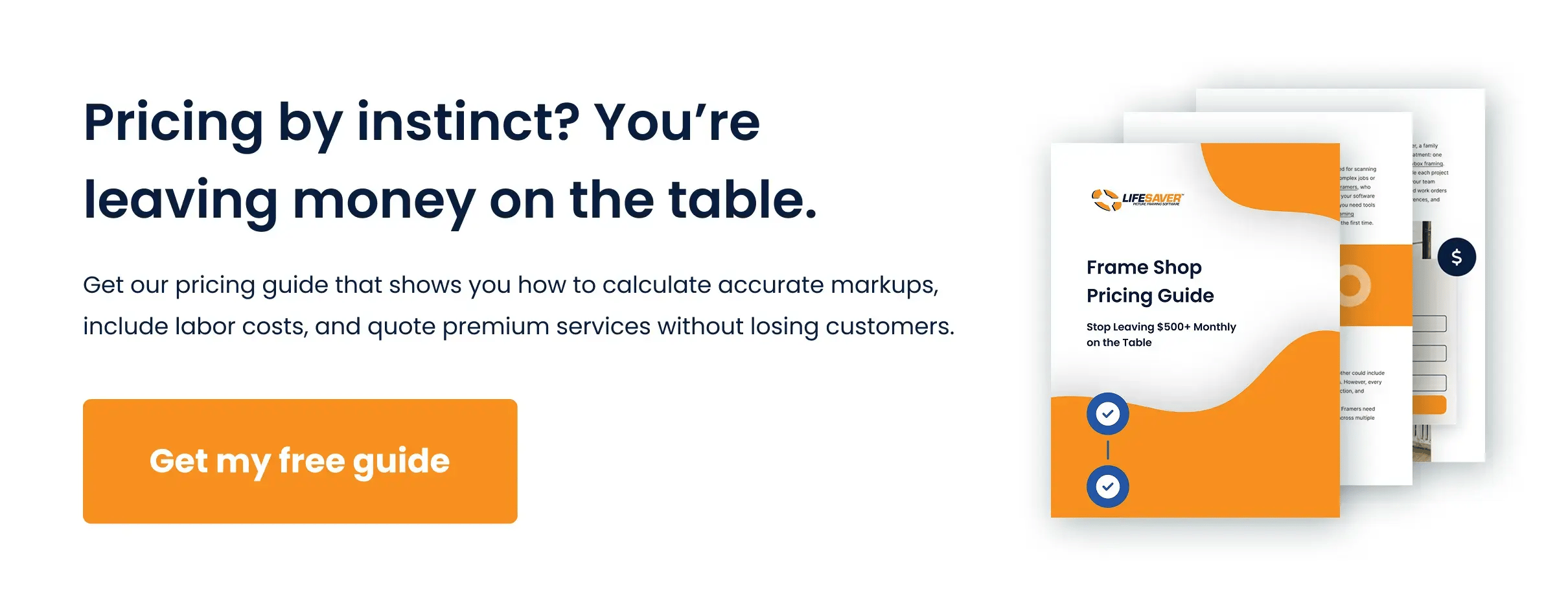
Custom framing is personal, but it must still be a business. If your pricing doesn’t reflect the time, skill, and supplies involved, your shop can quickly become a passion project that barely breaks even.
Healthy profit margins for a new business are generally between 10% and 41%. Well-run frame shops should aim for the higher end of that range.
In this blog, we break down picture framing profit margins, what affects them, and how to improve yours with practical, business-friendly changes.
What’s a Typical Picture Framing Profit Margin?
Gross profit margins for custom framing typically fall between 55% and 65% and depend on your location, clientele, and mix of services. That means for every $1 you make, you’re keeping $0.55–$0.65 after covering materials and direct labor.
Net margins, like rent, utilities, and marketing, are your take-home after overhead and are typically lower than profit margins. For example, a sample business plan for a framing shop projected net margins between 5% and 9% over three years.
These are helpful benchmarks, but real-world results vary. What matters most is knowing your own numbers and using them to guide pricing, inventory, and workflow decisions.
Factors That Impact Framing Profitability
Even strategic pricing can’t save picture framing profit margins if your costs are uncontrollable. Focus on these four areas to maintain profitability:
-
Track materials and supplies: Monitor your spend on moulding, mats, glass, and hardware. Bulk orders help cut costs — but only if the inventory moves. Lean into just-in-time ordering with trusted suppliers.
-
Monitor labor hours: Calculate how long jobs take from consultation to assembly. Create repeatable processes and consider outsourcing specialty work to free up time for higher-margin orders.
-
Build overhead into your prices: Include a flat fee or percentage built into each order to help cover monthly costs like rent, software, marketing, and insurance.
-
Reduce rework and waste: Measure twice, cut once, and test fit before final assembly.
Even small tweaks — like tighter waste control and smarter pricing — can lead to steady improvements in profit.
How To Calculate Your Profit Margin
Calculating profit margin for your frame shop is easy. Here’s the formula for gross profit margin:
(Revenue – Cost of Goods Sold) ÷ Revenue = Gross Margin
For example:
If a custom frame sells for $200 and materials plus labor cost $80:
($200 – $80) ÷ $200 = 0.60 = 60% gross margin
Don’t confuse markup with margin. In this case, you marked up the $80 cost by 150%, but your actual margin is 60%.
Margins tell you how much you keep. Markups tell you how much you added.
Because of changes to the cost of materials and labor, you should review pricing regularly to stay profitable.
5 Ways To Improve Picture Framing Margins
Increasing picture framing profit margins doesn’t always mean raising prices. Often, the fix is reducing waste, improving workflow, or tightening your pricing strategy.
Here’s how:
-
Reevaluate your pricing model: Add tiers based on complexity, set minimums for custom orders, and charge for design time or last-minute requests.
-
Reduce material waste: Avoid miscuts, over-ordering, and wasted supplies by putting together work orders carefully, double-checking measurements, and cutting only what you need.
-
Simplify your workflow: Break jobs into repeatable steps, especially for standard frame orders. Even minor process improvements, like pre-cutting standard mats, can save hours across the week.
-
Upsell and cross-sell intentionally: Suggest upgrades like museum glass or premium moulding during consultations. Offer extras like delivery, installation, or light restoration — simple, value-added upsells that increase order value without extra production time.
-
Digitize your work orders: Track every job from quote to pickup, set deadlines, assign tasks, and keep your schedule full — without confusion or delays.
Industry-specific tools like a point of sale (POS) system can improve pricing and tracking, while protecting your margins.
Should You Raise Prices?
If your sales are steady but margins are tight, it might be time to adjust your fees. Rising supply costs, consistently overloaded schedules, or labor-intensive jobs are all signs that your current pricing may no longer reflect the real value of your work.
Begin small with these strategies:
- Start adding a fee for consultations or design, including layout planning or color matching.
- Consider raising prices on complex services like shadowboxes or preservation framing.
- Increase rates on premium offerings first.
You don’t need to compete solely on price. Instead, show the value of your work:
- Present material options side by side.
- Use digital tools to preview finished pieces.
- Explain upgrades clearly so clients understand the cost difference.
When price increases are justified and transparent, customers will see the value in your work.
Want Higher Profit Framing Margins? Start With Better Tools
Healthy profit framing margins depend on accurate pricing, cost control, and organized operations. Industry-tailored POS software from LifeSaver supports all three.
With LifeSaver, you can create quotes and work orders, track materials and labor, and manage vendors in one place. It also lets you visualize jobs to upsell during consultations and analyze profit trends with built-in reports.
Want to earn more on every job? Start a free LifeSaver trial today — and frame your future with healthier profits, one order at a time.

May 29, 2025 10:00:15 PM





